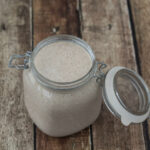
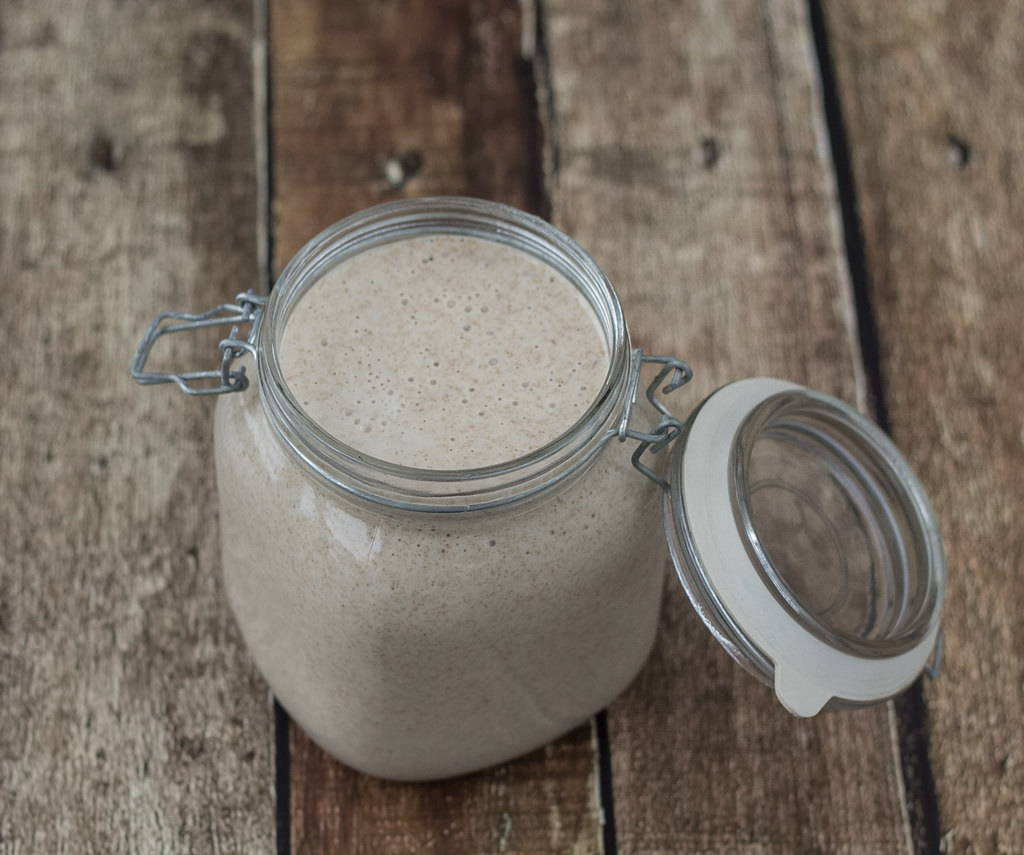
This is a simple tutorial how to make a sourdough from scratch. Sourdough is an important and great 'ingredient' when making chewy and dense bread with a crisp crust like the Danish and very popular rye bread. Making the first portion of sourdough is very easy and it only requires few and simple ingredients; all-purpose flour, rye flour and water.
The only downside is that it takes about 5 days to 'start' the first portion of a sourdough. Once it is 'up and running' it is easily maintained by 'feeding' the dough occasionally.
Also see: Recipe for traditional Nordic rye bread
As said, a sourdough is only made from flour and water - no yeast is added.
Instead, a sourdough is left in an uncovered bowl on the kitchen table and then it will slowly attract wild bacteria and yeast from the air. Over time microorganisms will start grow and fermented the dough. This process normally takes about 5 days.
See also: Recipe for Nordic rye bread made without sourdough
The dough is ready when it has small bobbles and when it smells nice and sour, like beer or a bit like vinegar. If you remember to use only the halve of the sourdough when baking, you can keep 'feeding' on the other halve and by that keeping it alive. If you use all of the dough, you would have to start a new one from scratch.
When making the first portion of sourdough the process can be speed up by adding a little honey, buttermilk or some yeast. However, this can also cause the dough to over speed and eventually turn bad - the simple version is very easy to control.

Ingredients
- All-purpose flour
- Rye flour
- Water
Instructions
Day 1
- In a bowl; mix 1 dl (1/2 cup) all-purpose flour, 1 dl (1/2 cup) rye flour and 2 dl (1 cup) water. Leave the bowl on the kitchen table without a lid.
Day 2
- Add 1/2 dl (1/4 cup) all-purpose flour, 1/2 dl (1/4 cup) rye flour and 1 dl (1/2 cup) water. Stir in the mixture on a regular basis.
Day 3
- Add 1/2 dl (1/4 cup) all-purpose flour, 1/2 dl (1/4 cup) rye flour and 1 dl (1/2 cup) water. Stir regularly
Day 4
- Add 1/2 dl (1/4 cup) all-purpose flour, 1/2 dl (1/4 cup) rye flour and 1 dl (1/2 cup) water. Stir regularly
Day 5
- The sourdough should now start to ferments, where small bobbles appears and the dough gets a nice sour smell. Make sure that you stir in the mixture several times a day. Sometimes the dough separates but that is ok - you just mix it together again. The sourdough is now ready to be used. You can keep it in a glass jar which has been cleaned with boiling water.
Notes
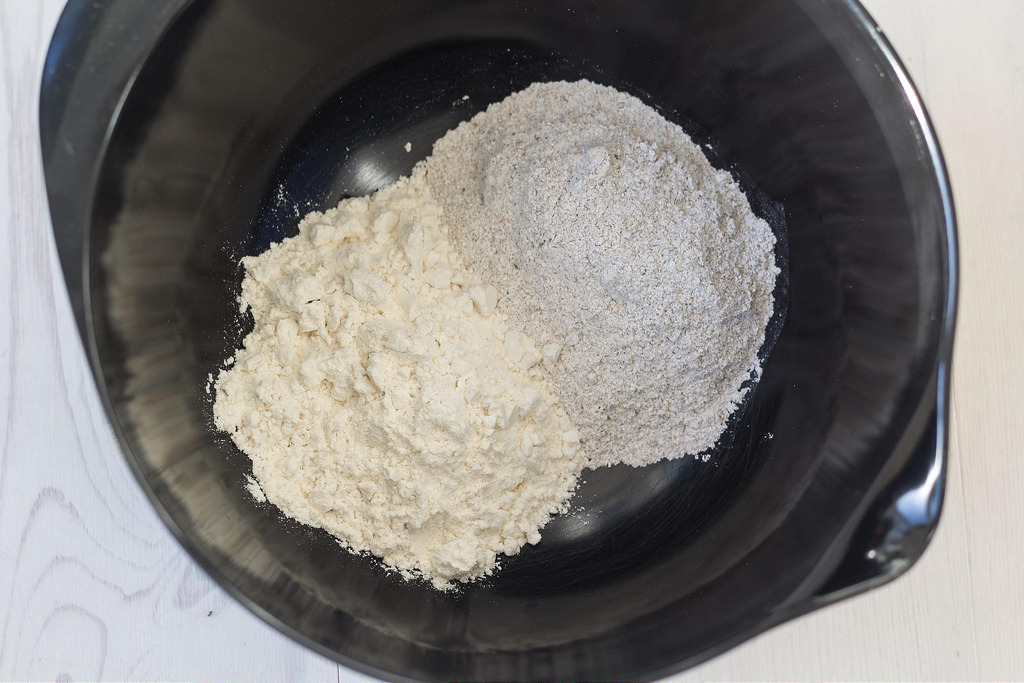

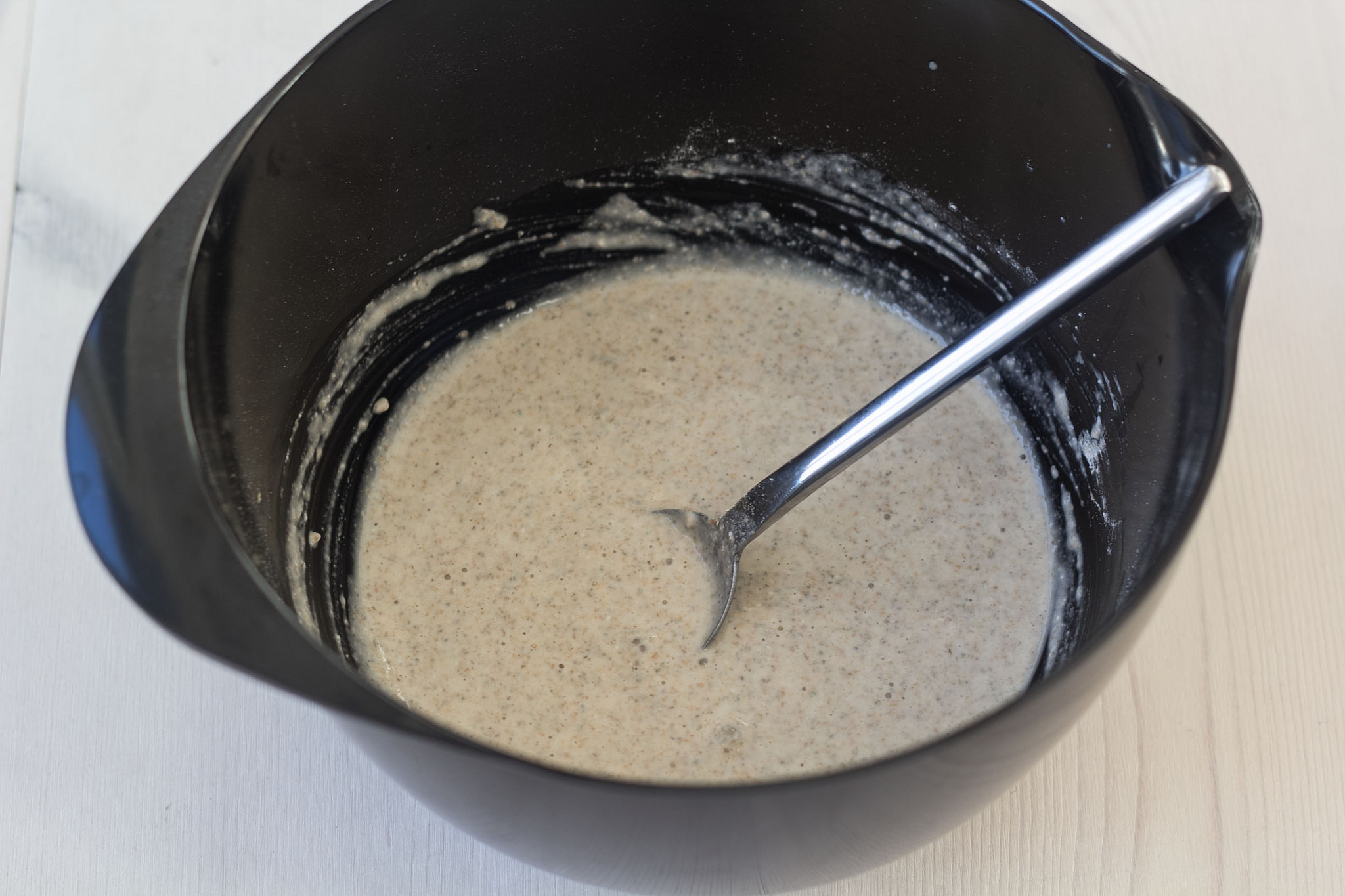
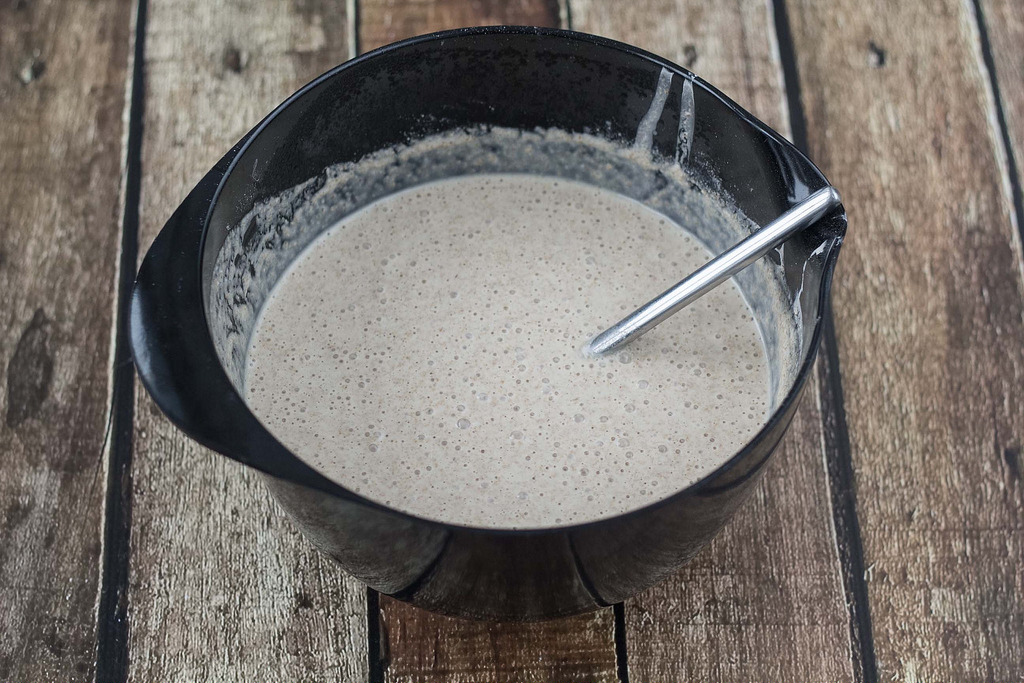

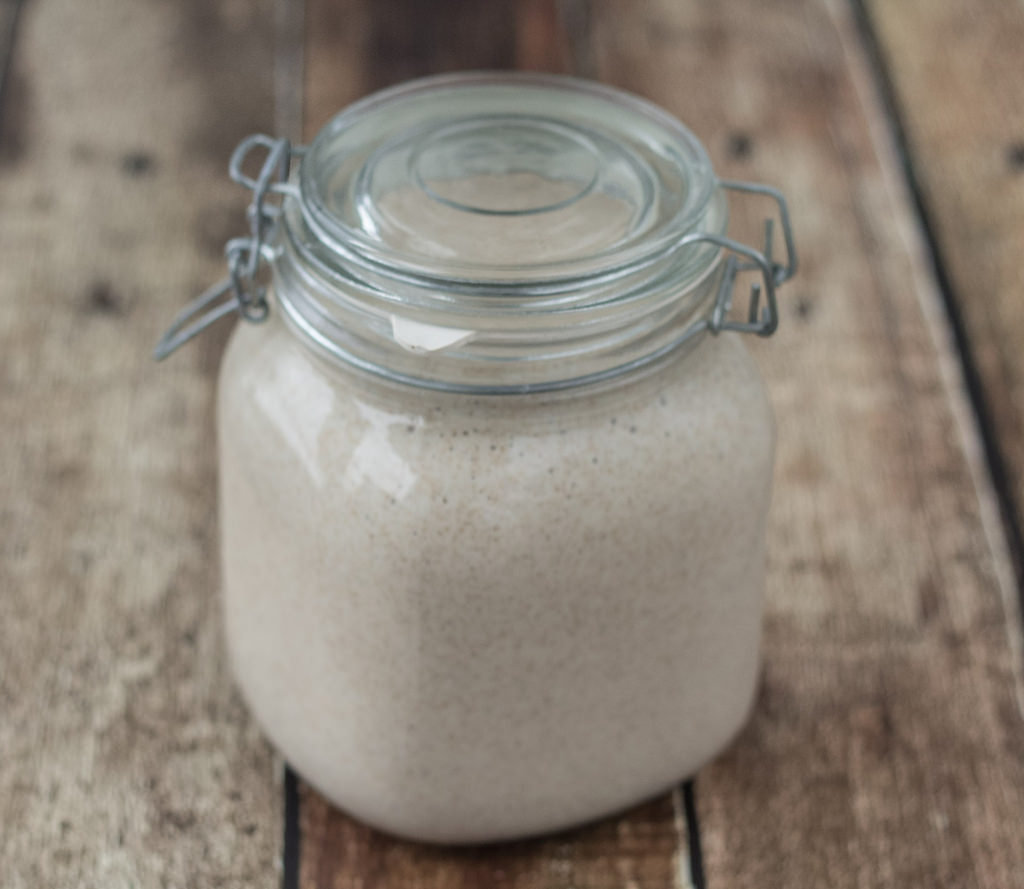
Hanner
Do you ever cover the mixture with a cloth? We live in an area where small flying insects would love to land in this mixture, especially as it ferments.
Louise Dam
Yeah some times I also have that problem. You can cover the mixture, no problem in that.
JoAnne Flynn
Hi Kim
We lived in Copenhagen Denmark for 3 years in association with the American Embassy. I LOVE the food - especially the bread. I love the excellent instructions you gave on how to make Rougbrod and am in the process of making the sourdough mix to try my first batch.
My question is: I don't understand the "dl" measurement which I haven't seen that often. The measurement I see more often in metric vs American/Imperial measurements is ml.
Can you clarify how a dl compares to ml. In some of the conversions I have found, some say 1 dl = 1- ml and some say 1 sl = 100 ml. Very confusing.
Thanks for clarifying.
Kim Nielsen
Hi Anne. I hope that you are enjoying the time in Denmark. I'll try to explain the 'dl' which means deciliter. A deciliter is a very typical way of measuring volume in recipes, at least in Europe. One deciliter is the same as 100 ml or 1/10 of a liter.
I always try to improve my recipes so that they are easily understood by people outside Denmark or Europe. So I am happy about you comment/question.
John Larson
Good website for lovers of Danish food! A couple of other suggestions:
For readers that live in the Pacific Northwest, you can buy this bread made fresh daily at Larsen's Bakery in the Ballard area of Seattle. You'll find other fine Danish baked goods there as well. And once you're there, be sure to visit another store called Scandinavian Specialties just down the road. They are an excellent source for many Danish delicacies made locally. The National Nordic museum is just a few blocks away too. Geat Scandi-lunch after viewing the exhibits. And for a backup plan for the bread, try Ikea's multi-grain bread baking mix called Knaada. Really easy to make and a pretty good alternative when you get desperate like I often do!
Beverley
Thanks for clarifying. A cup measurement is Australia is 250ml- so perfect to have the dl explanation- we use metric here!!!
Laura
I use grams in all my bread recipes. 1 dl = 100 g
Darien
For something like sourdough starter, where precise measurement is not at all important, that's a reasonable conversion. However, the ml/gram comparison is true of water. For flour it will depend on the type of flour, whether sifted or not, etc.
Peter storey
One dekaliter (dl) will = 100 g with you’re measuring water. Other things may weigh differently. Metric definition says 1 g = 1 ml of water. there 100 ml in a dl.
Jonathan Dormer
You picture storing this in a glass jar with spring loaded lid. Is not there a build up of pressure as it continues to ferment?
Fiona
Thanks for posting this. Just got back from our first visit to Copenhagen and we loved the food there. Have never tried making a sourdough starter but will give it a go.
Louise Dam
I hope you loved the city. Good luck with the baking :-)
Luke
My sour dough starter is not as bubbly as yours appears to be, what did I do wrong?I do have bubbles but it doesn't seem as active as it should be.
Btw, thanks for the recipes!
Louise Dam
Hi Luke
Hard to say, maybe just let it sit for an extra few days.
FJ
On day five of our sourdough "Yoda". Feel like it has become one of the family, sitting on the kitchen table. We always say hello, good morning etc :-D Looking forward to getting started on the rye bread this evening.
Louise Dam
Ha ha, I love that you called it Yoda :-) Hope the rye bread turned out great!
Mima Maria
Hi Louise, thank you very much for these starter dough instructions. I live in Florida where it is super hot right now. My starter bubbled over on day five and smelled a bit like vinegar or like it got over sour. Can I still use it? It does not smell spoiled or rotten just that it seems to be super active and have a very strong sour smell. Not sure if I should throw it away and start over or if I can use it. I'd greatly appreciate your help. Thanks so much!
Kim Nielsen
Hi Mima. The sourdough can sometimes be a little tricky. I know it can be super hot in Florida, I visit the state some years ago. I would recommend to try one more time and then keep the sour dough a cooler place and out of sun light. I can only think that the sour dough has been exposed to too much heat. Regards Kim
Suzy
Hello and thank you for sharing this recipe! I have the same "problem" as Mima. I live in Italy and my sourdough is bubbly already on day 2. Is that OK? Should I keep going like this until day 5 or should I skip a couple of days? (I keep mine in the kitchen, but I could try to move it into the basement where it is cooler?)
Kim Nielsen
I have looked more into this "problem" which I actually think is not a problem. When the sourdough bobbles and looks funny it's ready, then you just skip some days and continues to keep it alive. The correct smell is a bit sour, beer taste or a little like vinegar. If it smells rotten then you should throw it out and start over from scratch.
I hope this helps. Regards Kim
Suzy
Dear Kim,
Thank you so so much for your quick reply - I really appreciate it as I was desperately and hopelessly looking for an answer about what to do...I would hate it if the sourdough went bad! :( I guess the smell is as you are describing it right now, I will try to keep it cool and then use some of it to make your chocolate rye buns tomorrow. Can't wait! I just hope that it will be OK until tomorrow morning.. By the way, if I don't have any access to rye grains what could I use instead? I have some rye flakes, but not sure if I could use that instead?
Anyhow, I will let you know how it goes!
Ps. Even though I live in Italy we are actually neighbours - I come from Sweden! :)
Godnatt! :)
Kim Nielsen
Hi Suzy
Thanks sounds great. I'm looking forward to hear how it went. I know it can be a little difficult to make these buns/bread. But when you get it right they are super. It's difficult to say about the Rye Flakes if they will work. I think the rye grains are the best. However, you might also get a good result with the flakes. I'm also really interested in hearing if you get any good experience with rye flakes.
Sweden, yes then we were almost neighbors. I'm living in Copenhagen.
Regards Kim
Suzy
Dear Kim,
I actually decided to await until day 5 anyway, which I'm glad for doing since the sourdough is getting stronger and stronger for each day - you should see it - it's really bubbly and the smell is perfectly sour, but in a good way! :) I also placed some organic ripe fruit from our farm next to it which just seems to add to its fermentation process....It's always hungry, and this morning I found some "hootch" on the top of it which I poured away (they say it's a sign of starvation?) Anyway, tomorrow will be day 5 and I guess I will start with the buns tomorrow or the day after. I will let you know how it goes! :) If you want you can follow us on Instagram (terra terra.co) to see the result through images (We just started to follow you as well of course!)
LIsa
Hello! I just wanted to thank you for the great recipe, pictures and tutorial. I am making your Rye Bread with grains and using your sourdough recipe. Looks very good and easy to follow, Nice video too. I will be reading your blog, Thanks! Lisa from Ventura, CA
Kim Nielsen
Hi Lisa. Thanks for your nice comment - I am happy that you like the recipe :-)
Christine Watson
I cannot find any rye flower. Both sets of my dad's grandparents came from Denmark. I had a start of sour dough years ago from my mother who got it from my grandmother who got it from her mother who got it from her mother. But I ended up throwing it out a long time ago. Anyway I would like to make a Danish sour dough mix again. I do have several recipes from my grandmother to make bread, pancake etc. Thanks.
Christine, from
Tucson AZ
Shahida Lotfi-jad
Hello Kim,
I just came across your instructions on making sour dough. Most of the other recipes ask that half of the sourdough starter should be discarded daily and an equal amount of fresh flour and water be added.
Your instructions do not indicate this.
Your instructions seem to be easier to follow. My son's girlfriend is Danish and i would love to surprise her with a decent Rye bread when she visits us in Vancouver. I do bake a lot for charity and friends..
I look forward to hearing from you. Thanks for the posting.
Thanks for the posting.
Kim Nielsen
Hi Shahida. Yes I know that some recipes suggest this step. However, I have always just used this recipe I have here on my blog with success. I hope that it works out for you. Regards Kim
Vicki
I know it’s a late reply! I used to live in Tucson but have since moved, but I get my rye flour at natural grocers which we had in Tucson.
Gina
I'm making this sourdough for your danish rye bread but I'm not sure about something.
After I've taken out 1 3/5 cup of it for the bread, when feeding what's left in the jar do I continue to use the same amounts of rye and AP flour and water for feeding every 14 days? It seems to me eventually there will either be too much or too little in the jar, depending on how often I make bread.
Kim Nielsen
Hi Gina. Yes if you keep the sourdough in the fridge, just feed it with 1/2 dl (1/4 cup) all-purpose flour, 1/2 dl (1/4 cup) rye flour and 1 dl (1/2 cup) water every 14-days. You can also just keep it on the kitchen table and feed it everyday or every second day with the same ratio of AP flour, rye flour and water. Hope this helps. Regards Kim
Chelsea Eaton
I let my dark rye sour dough starter dye and am now starting over. I can't find my original recipe source and came across yours which I want to try. However, I remember my first time doing this, it called for yeast. Is there a reason why yours doesn't require yeast? Thank you
Kim Nielsen
Hi Chelsea. The reason why my sour dough doesn't require yeast is because it gets the 'yeast' from the air in your kitchen. Some recipes adds yeast which is a sort of a catalyst to speed up the process of making sour dough. I normally perfer sour dough made without yeast. I hope this answers your question.
Chelsea Eaton
Thank you Kim, I look forward to trying it without yeast in 3 more days!
Steve
Doesn't the yeast come from the flour?
Kim Nielsen
Yes, the yeast-effect is coming from the flour.
Stella Galopoulou
Great blog.
I am from Greece and love Nordic food. I believe that Mediterranean and Nordic food together is a great combination
Great recipe. i just made my first batch of sourdough and used it for bread. and it came out perfect.
i actually wanted to do the Rye Choc recipe as I am often travelling to Kastrup and just fell in love with this rye chocolate bread cookies.
Yesterday was the 6th day of the sourdough. I have some questions on the maintenance.
1) If i want to use it today do i need to feed it for one day?
2) When I use some is it better to replace it immediately?
3) Do i always need to feed it with the quantities mentioned or can i add more but keeping the ratios?
Thank you
Kim Nielsen
Hi. Thanks for your comment. I'm happy that you like my blog and the recipes on it. Regarding your questions: normally you don't need to feed it on the day 6th day when it is ready. However, if you uses some of the sour dough on the 6th day, you can just feed it after to continue keeping it alive. You can try raising the quantity of flour a little bit but I would normally use the quantities I have listed in the recipe.
Kimberly
Hi Kim: I have made this recipe consistently since my trip to Denmark last August= thank you for it! Couple of observations:
1) After I add the bulk of the flour and before putting it into bread pans, and then again after I add it to bread pans, the dough doesn't rise. Can I skip this step and just put it in the oven? At least skipping one rising session?
2) It's hard to get this bread fully baked. I only eat it toasted, because it's so dense and then it "bakes" a little longer. I've experimented with the oven temperature and start out at 375 for 30 minutes to get a brown crust, then go down to 325 or 350 for an hour an a half. Ay thoughts on this?
Thank you so much,
Kimberly
Zelda Caldwell
I couldn't believe it when I saw you had a recipe for the very same rye chocolate buns that I had sampled at that famous Copenhagen bakery you mentioned. I'd never had anything like them before, and I am so excited to make them! One question: when you store the rye sourdough starter in the refrigerator should it be covered? Thanks so much!
Kim Nielsen
Hi Zelda. Yes I normally cover the sour dough when I store it in the fridge :-)
Zelda
Thanks! I am not seeing as many bubbles as you have, so I am going to let it go a little longer.
Can you tell me if your recipe is different than those one would find on U.S. websites. I'm seeing pictures of stringy elastic looking starter, but yours looks more soupy than that. Danish rye bread is different than the sourdough they are making, so it would make sense that the starters would be different. Right?
Kim Nielsen
Hi Zelda. I'm not quite sure how the 'us Ryebread' is compared to danish Ryebread. My sour dough is quite liquid and has a nice sour smell. I know other types of sour dough which are less liquid - those should also work.
JoAnne Flynn
Some sour dough recipies suggest that about day 22 or 3, you discard about a cup or so of the starter.
I was wondering why you would need to do that and if it would affect your final bread ?
I made your recipe. On the whole it was great ! The only think I noticed was that once I put it into the special Danish bread pans I bought in DK, it didn't really rise any more. Therefore my final loaf was about half as "tall" as yours and other loves I have seen. I wonder why that would be ???
Thanks for getting back to me
Patricia
Like so many others I visited Copenhagen recently and LOVE this bread and Smorgasbord. (Sp?) I will be trying your recipe this week. Wish me luck. :-)
Barbara O'Connor
Trying for the first time in the UK. I have managed to source all the ingredients but can't find rye kernals locally. Guess I will have to try on line. Any idea of a substitute I could use?
Nancy Wagner
I found rye kernels at a natural food store, or health food store, not at a grocery.
Mathilde Windinge
Is there any way you would know that it is done? I saw another video where it said that when you put it in a jar it would double in size. I tried that with this dough and it didn’t do that so I got confused and started over. But the dough I’ve made this time doesn’t do it either so maybe this dough is not supposed to? Would love a tip on how to know that it is ready to use. Thank you
Anders
Hej Kim, a fellow Dane here. Just a couple of questions. I understand that during the initial process of creating the sourdough I leave it on the kitchen table. But once it is finished and I keep it alive in the jar while feeding it every 14 days it is fine for it to be in the fridge or should it be on the kitchen table some of the time? Also when taking some out to use it should that be taken out 24 hours before being used? Many thanks for all the tips.
Kim Nielsen
Hi Anders. You can leave the sour dough in the fridge if you just remember to feed it a little every 14 days. In this time just keep it cold in the fridge. When you want to use some of the sour dough for cooking, take it out of the fridge and let it heat up on the kitchen counter top for about 24 hours.
Thêvy
Oh and also my sourdough develops a pretty thick « skin » when left alone for a few hours (like when you make hot milk). I just mixed it back in every time, is that okay?
Kim Nielsen
Yes just mix it back in to mixture.
Dave
Hi. I'm on day 5 and my sour dough still doesn't have any bubbles. I've followed the steps every day. It does have a strong smell - I'm not sure if it's gone bad but the smell is not very nice, almost like when a baby spits up.
Should I toss it and start over? Thanks.
Kim Nielsen
Hi. It sounds the your sour dough has gone bad. I'm not sure where you are from but if you are from a warm climate like Florida or Thailand. You could face problems that the hot ambient temperature will accelerate the sour dough. I will recommend keeping it at a shady and cool.
Vincenzo
Hi;
I just wanted to say that I followed your recipe and now my sourdough is two years old.
Thank you so much , Vincenzo :)
Kim Nielsen
That's good to hear. You are welcome:-)
Nancy Wagner
Here in St. Louis Missouri, USA, our adult kids are hosting a young man from Denmark for this year, and the thing he missed most from home was Danish rye bread! So his grandmother sent us this recipe from you. In the first batch I used dark rye flour which was overpowering in rye flavor. So I switched to regular whole rye flour and the second batch was perfect. The sourdough is ripe and fragrant smelling, and now that the recipe well-suits him, we are all very happy and will continue to bake this bread regularly for him. The nice thing is that we love it too! Thank you so much.
I had to do a lot of hunting to find all the right ingredients, and got some quickly from Amazon.
wen
Hi, I'm from California, USA. I really like your recipes. I have 2 questions with making sourdough:
1. Do you mean only Day 1 is *NOT* covered? Or, Day 1 to Day 5 all are not covered?
2.When using the same jar as yours to keep/maintain the sourdough, isn't no air for the wild yeast?
Some blogs I read saying don't cover it too tight.
I have the same jar as yours and I want to use the same.
Thank you,
Kim Nielsen
When I'm making the sour dough I'm just using a bowl without a lid (like the one in my pictures). When I'm keeping it in the fridge I'm transferring it to a glass jar with a lid.
C
I am thinking about starting this sourdough so I can make rugbrod. I went very briefly to Denmark a few years ago and still think of the bread! I make your recipe for rodkal often and have it with store-bought rye, bagels from a good deli, or with rieska, which is Finnish but quick to make. I'd like to have it properly with rugbrod. While I have time now to make the sourdough, next month I will be away for 2 weeks for vacation. If I feed the sourdough right before I leave and then when I return, would it be all right?
Also, is it possible to make a halve this recipe? This recipe looks like I will end up with 5 cups. I cook only for myself, so I can't imagine I'd want that much!
Kim Nielsen
Yes it is possible to halve the recipe. If you leave for vacation then it is a good idea to keep the sour dough in the fridge and then feed it right before you leave and then again when you come back.
Constanza
Hi! For some reason my sourdough is not making any type of bubbles some days, I live in Cph, and I keep the windows open most of the time, I thought that it was because of the temperature so I put it in the oven with the light on, and it grows some days others it doesn’t even make much bubbles, do you know what could be Thank you!
Kim Nielsen
That sounds a little strange. Try just keeping it in your kitchen without open window. Maybe it got a little too cold during the nights? Is it the same batch?
Thêvy
Hi! First of all, thank you a lot for the recipe! I visited Copenhagen 3 times before and completely fell in love with it and literally became obsessed with the bread!
I started making the sourdough 2 days ago so it is day 3 now and yesterday night it was already starting to smell a little funny. It’s already smelling a little bit like beer. I love in South East Asia where it is hot and humid (it is rainy season right now) so I was wondering if maybe that was speeding up the process? Do you think I can use the dough now to make rye bread?
Thank you 😊
Kim Nielsen
I happy that you enjoyed your trip to Denmark. I have also travled quite a lot to the south Asia in the resent years and I love it. If you live in a hot area like many places in Asia, yes the process will speed up. The hotter, the faster. If you already have enough sour dough for your bread, then just use it. Keep feeding it and keep it in the fridge when done.
Anna
Just started the process! Is it supposed to be uncovered every day?
Thanks!
Kim Nielsen
Yes the sour dough is made without a cover. Regards Kim (NordicFoodLiving.com)
Zach A.
Hej Kim!
I was looking for a Danish rye bread recipe and was unfamiliar with your website. I saw your picture first, thought you looked familiar, then saw your name and realized I know you from RPI! I'm about to get my sourdough starter started. Thanks for sharing your recipes! :)
Kim Nielsen
Hej Zach. I hope that you are doing well. Long time, no see :-) I hope that you can use the recipe and make a nice Danish rye bread. Regards Kim
R Petersen
For the Sourdough, use dark rye flow or regular? I am using dark, and it really has a strong acidic smell when immediately mixing in the water and unbleached flour.
Kim Nielsen
In theory you can use both types of flour when making sourdough. However, I normally use regular rye flour because that's what I have.
Simi
Hi there, I’m making the sourdough starter as I want to make the chocolate rye rolls. However it’s day 5 and there’s not many bubbles in my starter. Will that be a problem?
Kim Nielsen
Hi - a sourdough can be depended on the place that it is made. It can take longer to make a sourdough if you live in a colder climate/house compared to a hot and humid environment like Florida, US. I would try giving it some extra days continuing adding flour and water like the last days. I hope that it will succeed for you. Regards Kim (NordicFoodLiving.com)
Moti
Hi Kim,
I had a chance to prepare ryebread with the sourdough recipe on several occasions and really loved it.
With just a little more experience than before, do the amounts of water and flour refer to volume or weight?
It seems like the sourdough is with hydration larger than 100%.
Is it ok?
Thanks!
Kim Nielsen
Hi. In this recipe the water and flour refers to volume. In a perfect world it would be best to use weight as a way of measuring. However, I have had success with this recipe many times. That is way I use volume. It should be OK. Regards Kim (NordicFoodLiving.com)
Moti
Thanks Kim, just what I followed.
There's always something to learn in this fascinating world :-).
Yelena Zaslavskaya
Dear Kim,
The best rye bread I had in the last 10 years was in Copenhagen. Now I am trying to bake rye bread myself. The problem is I cannot buy rye grains. I am willing to purchase it from Denmark or Germany, but I am not sure how to do this. Online they sell (if they sell) very expensive and quality? If you know how to order 30- 50 pounds from Denmark I would be just happy.
Best, Yelena
Kim Nielsen
Hi Yelena. I know that it can be difficult to find the ingredients for rye bread when you are living outside Denmark. I have just searched on Danish webshops and found one called "Bagetid" means "baking time". They sell "skårne rugkerner" which is "cracked rye". The prices seems fair and they can ship oversea. The site is in Danish but if you insert the site address directly in Google Translate then you can get the site in English. I suggest that you try to contact them and ask for the shipping costs. Here is a link to the site https://bagetid.dk/shop/11-raavarer/4897-skaarne-rugkerne---1-kg/. I hope this helps. Let me know if it doesn't work then I will help you. Regards Kim (NordicFoodLiving.com)
Yelena Zaslavskaya
Hi, Kim!
Thank you so much for your response. Unfortunate, I have found your letter just today. I was waiting for it in my inbox, but it is in my recipe folder. I don't understand how it works. Anyway, I am happy to see your advised and your link to the site. I will try it right now. Just in case my e-mail is lavyelena@gmail.com
thank you a lot and again, sorry for my delayed response.
All the very best and stay healthy, Yelena
Jess
You need to show the picture of the jar with with started overflowing onto the counter 😬 😂
Kim Nielsen
Haha yes I will remember to take a picture of the sous dough overflowing the next time :-) Regards Kim (NordicFoodLiving.com)
stephen pope-carter er
Yet another so - called sourdough site showing starter in a tightly sealed kilner jar... Enjoy your exploding glass...
Kim Nielsen
I have used this type of jar several times without any explosion. However, you are right maybe it is a good idea to use a jar where the lid is not 100 % air tight. Regards Kim (NordicFoodLiving.com)
Darien
I wonder if it occurred to you before making a snarky comment instead of a friendly one that this post has been here for years. While it certainly is true that gases are created in fermentation, hot air escapes from other places in less constructive ways as well, don't you think?